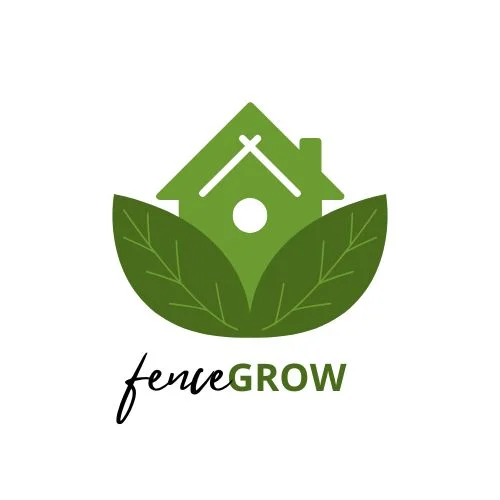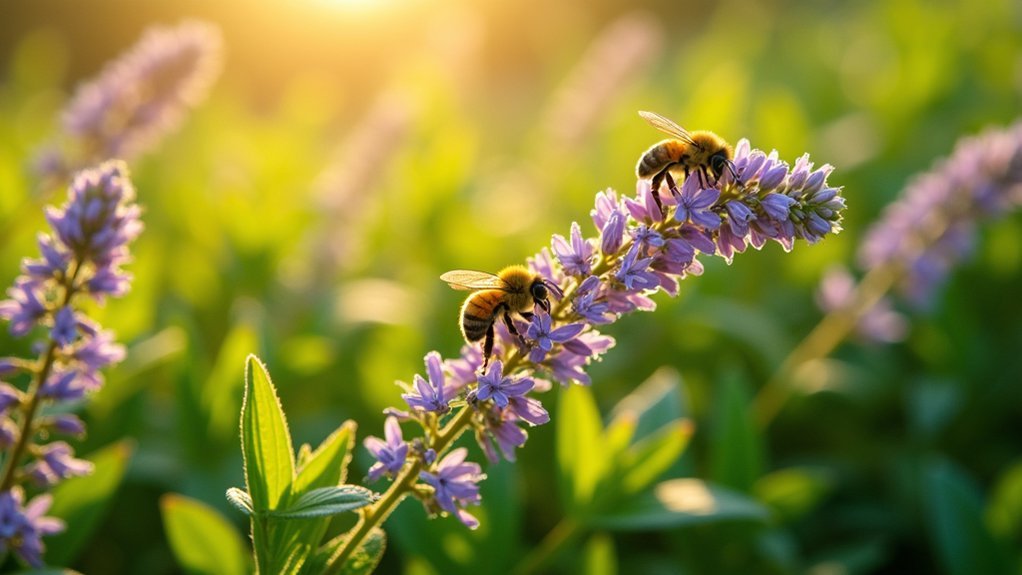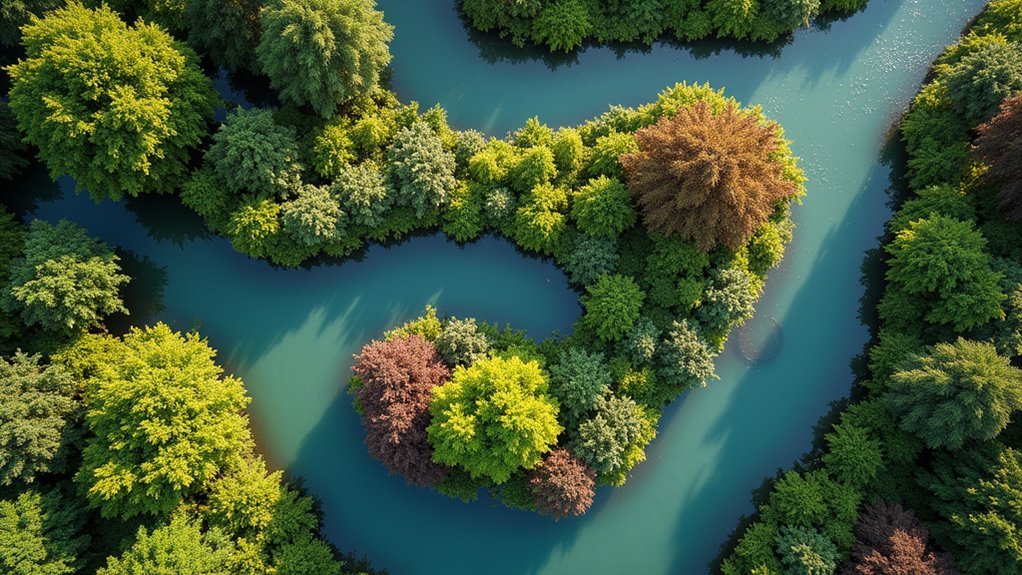Edible hedgerows transform your garden boundaries into pollinator havens while providing delicious harvests. You’ll want to include early bloomers like hazel and pussy willow for spring support, followed by elderberry, blackthorn, and crab apple for summer nectar and autumn fruits. These plantings can boost bee survival rates from 35% to 100% by offering continuous food sources and shelter from harsh weather. Beyond beauty, these living fences create thriving ecosystems where bees and biodiversity flourish together.
Why Bees Are Buzzing About Edible Hedgerows

Why are bees increasingly drawn to edible hedgerows? The answer lies in survival rates. When you add early-blooming plants to hedgerows, bee colony survival jumps dramatically from 35% to 100%.
These living borders provide critical sustenance during the “hungry gap” of early spring when queen bumblebees desperately need nourishment.
Your hedgerow’s seasonal progression creates a continuous food supply, with spring’s pussy willow and blackthorn giving way to summer margins that feed pollinators when crops aren’t flowering. Hedgerows also offer thermal refuge during extreme weather, creating cooler microhabitats up to 15 degrees lower than surrounding areas.
During autumn droughts, these plantings become primary food sources. Beyond feeding, hedgerows increase rare native bee populations sevenfold compared to untended borders.
Top Flowering Hedge Plants That Double as Bee Buffets
Creating a flowering hedge that satisfies both your landscaping goals and the nutritional needs of bees requires strategic plant selection.
Consider Japanese cherry and willow species for essential early-season pollen, when bee colonies are most vulnerable.
For summer sustenance, incorporate lavender’s accessible nectar-rich blooms and bee balm’s tubular flowers that attract specialized long-tongued species. Foxglove beardtongue adds white blooms particularly appealing to bumblebees. The Smooth Blue Aster included in native collections provides beautiful late-season blooms that help sustain pollinators into autumn.
Choose plants with diverse flower structures—open-faced blooms welcome multiple species, while flat clusters create efficient feeding platforms. Native options like golden alexander and showy goldenrod provide superior support with minimal maintenance.
Remember that proper care matters: practice selective pruning to preserve flower buds, avoid pesticides that harm bee larvae, and stagger plantings to guarantee continuous blooming from spring through autumn.
Creating a Four-Season Feast for Pollinators

To transform your hedge into a pollinator paradise year-round, you’ll need to plan for continuous food sources across all seasons.
You can start with early-blooming shrubs like witch hazel or pussy willow for spring nectar, shift to summer favorites like butterfly bush or rugosa rose, and finish with late-season performers such as aster or sedum. Consider adding Prairifire Crabapple trees with their dark red-purple fruit to provide additional food sources for pollinators.
Don’t forget to include plants with winter berries, seed heads, and sheltering evergreen foliage that help bees and other pollinators survive the harsh winter months when resources are scarce.
Spring Nectar Sources
When spring awakens the natural world, early-blooming plants become essential lifelines for hungry pollinators emerging from winter dormancy.
You’ll want to include Winter Aconite, Snowdrops, and Witch Hazel as your earliest offerings, followed by pollen-rich Willows with their nectar-laden catkins.
Don’t overlook Common Violets, which thrive in shade and provide food for both mason bees and fritillary caterpillars. Research shows that dandelions offer crucial early spring forage and delaying weed control treatments can significantly benefit bee populations.
For longer blooming periods, plant English Lavender and Bergamot (Bee Balm), which attract multiple pollinator species with their fragrant blooms.
Consider adding Winter Jasmine, Heather, and Mahonia japonica for late winter sustenance.
When designing your garden, incorporate a diversity of native plants like Coneflowers, and leave portions of your lawn natural to encourage wildflowers that sustain pollinators throughout the season.
Summer Pollinator Paradise
As temperatures rise and daylight lengthens, your garden can transform into a buzzing hub of pollinator activity with the right selection of summer-flowering plants.
Create a vertical feast with upright plants like yarrow and phlox paniculata, whose flat flower clusters attract multiple pollinators simultaneously. Add borage and monarda (bee balm) to draw in honeybees and hummingbirds with their nectar-rich blooms. Monarda’s whorls of tubular flowers create a magnificent display while providing essential nutrition for diverse pollinators.
Don’t forget rudbeckias, coreopsis, and the essential milkweed (Asclepias) for butterflies. For consistent blooms throughout summer, include Texas Blazing Star and sunflowers (Helianthus).
Plan for late summer by incorporating Russian sage, asters, and goldenrod, which bridge the gap into fall.
Choose drought-tolerant natives when possible—they’ll need less maintenance while providing maximum pollinator support during summer’s heat.
Winter Survival Resources
While summer gardens burst with color and activity, winter months present serious survival challenges for our essential pollinators.
Your hedge can become a life-saving winter sanctuary by incorporating late-blooming plants like Goldenrod and Calico Aster alongside early spring bloomers such as fruit trees and Viburnum species.
Don’t rush to tidy up in fall—those dead stems and leaf litter provide vital hibernation spots for native bees. Bumble bee queens particularly benefit from these spaces as they spend winter underground in protected cavities before emerging to start new colonies in spring.
Leave patches of undisturbed soil where ground-nesting species can overwinter safely.
When temperatures climb above 55°F, early-emerging pollinators will desperately seek food sources.
Fruit-Bearing Hedges: Sweet Treats for Bees and Humans

You’ll discover that fruit-bearing hedges like elderberry, blackthorn, and wild cherry offer dual benefits—providing delicious harvests for your table while supplying essential nectar and pollen for bees.
These nectar-rich hedgerows attract diverse pollinator species throughout the growing season, creating a natural ecosystem that improves both fruit production and bee health. The resulting fruits serve as a critical food resource for UK farmland birds from late summer through winter when other food sources become scarce.
Berries for All Seasons
Gardeners seeking to create a year-round buffet for pollinators need search no further than berry-producing hedges. By carefully selecting varieties that bloom in succession, you’ll support bees from late winter through autumn. Most berry bushes thrive in full sun conditions, maximizing their flower and fruit production.
| Berry Type | Pollinator Benefits |
|---|---|
| Cornelian cherry | February-March flowers critical for early-emerging bees |
| Rock pear | April-May blooms support peak spring bee activity |
| Blueberries | Bell-shaped, nectar-rich flowers; extend season with early-to-late cultivars |
| Pomegranates | Multiple stamens provide abundant pollen through summer |
| Elderberry | Flat-topped white flower clusters attract diverse pollinators |
For maximum impact, pair your berry hedge with complementary groundcovers like yarrow, which attracts beneficial predatory insects. Don’t forget to leave some fruits unharvested—birds that feast on your berries will help control garden pests naturally.
Dual-Purpose Edible Varieties
Creating a hedge that doubles as both a bee sanctuary and a personal harvest station offers the ultimate win-win for ecological gardeners.
You’ll find blackberries particularly versatile, forming dense hedges while providing sweet fruits and habitat for beneficial insects.
Consider incorporating elder trees, whose flowers and berries attract pollinators throughout growing seasons while offering you ingredients for beverages and desserts.
Rugosa roses deliver vitamin C-rich hips for your teas and jams while their fragrant blooms delight bees.
For year-round structure, natal plum provides evergreen foliage and edible fruits.
Hazels contribute spring catkins for early pollinators and nutritious autumn nuts for you and wildlife alike.
Blackthorn serves triple duty with bee-attracting blossoms, sloes for your homemade gin, and dense cover that protects garden visitors through winter.
Pomegranates create striking hedges with their bright orange-red fruits and can thrive in gardens located in USDA zones 7-10.
Nectar-Rich Fruiting Hedges
Fruiting hedges offer a spectacular dual benefit as they transform your garden boundary into a vibrant ecosystem for pollinators while providing delectable harvests.
These living fences burst with white and pink blossoms in late spring, creating a bee paradise packed with essential nectar and pollen.
You’ll find crab apple, hawthorn, sea buckthorn, elderberry, and blackthorn particularly effective for supporting diverse pollinator populations.
These resilient plants not only shelter bees from harsh weather but continue feeding them through seasonal changes—flowers in spring, fruits in fall. The fruits produced also provide essential food sources for birds, further enhancing biodiversity in your garden ecosystem.
Plant your fruiting hedge in well-draining soil with full sun exposure.
Maintain it with annual pruning to encourage healthy growth and abundant fruiting.
With proper care, you’ll create a lasting landscape feature that nourishes both pollinators and your family for years to come.
Native Hedgerow Species That Support Local Bee Populations

While many gardeners focus solely on flowering perennials for pollinators, native hedgerow species offer exceptional support for local bee populations throughout the seasons.
You’ll see remarkable results by incorporating early bloomers like manzanita, serviceberry, and hazel shrubs that provide critical nectar and pollen when bees first emerge in spring.
Pussy willow and maple trees can dramatically increase bee colony survival through the “hungry gap” period.
Don’t overlook the power of native forbs like goldenrod and coneflower that maintain late-season food sources.
A well-designed hedgerow mixing native shrubs, trees, and wildflowers creates structural diversity that delivers both nesting habitat and continuous bloom succession. Consider consulting the Pollinator Conservation Resource Center for region-specific plant recommendations that thrive in your local climate.
This approach supports rare native bee species and strengthens agricultural ecosystems by maintaining pollinator diversity throughout your landscape.
The Perfect Planting Combination for Maximum Bee Appeal
You’ll boost your garden’s appeal to bees by pairing early bloomers like wild privet with late-season flowering species such as China Girl holly.
For a visually stunning bee buffet, combine complementary colors that naturally attract pollinators—try the yellow flowers of barberry against the white blooms of Russian pea trees.
These strategic combinations guarantee your hedge provides continuous nutrition throughout growing seasons while creating an eye-catching display that draws beneficial insects to your landscape. Including ivy in your hedge design ensures bees have autumn food sources when most other plants have stopped flowering.
Seasonal Planting Pairs
Creating strategic plant pairings throughout the seasons guarantees your hedge offers continuous nourishment for bees year-round.
In spring, combine apple trees with dill or pair redbud trees with bleeding hearts to jumpstart the pollination season. Grouping these plants together increases attractiveness to honeybees searching for early season food sources.
Summer calls for vibrant duos like cosmos alongside bee balm or sunflowers with wild bergamot to maintain steady nectar flow during peak bee activity.
When autumn arrives, mix asters with goldenrod or echinacea with mint to support bees preparing for winter.
Don’t overlook year-round options—rosemary and thyme create an evergreen foundation, while various coneflower varieties assure consistent blooming cycles.
For climate versatility, incorporate elderberry with lemon balm or oak trees with hostas to accommodate regional growing conditions.
Color-Coordinated Bee Buffets
Bees possess remarkable color vision that guides their foraging activities, with strong preferences for blues and yellows that signal nectar-rich blooms.
Creating a visually attractive buffet for these pollinators not only enhances your garden’s beauty but greatly increases bee visitation.
When planning your bee-friendly hedge, focus on these proven combinations:
- Yellow-Blue Contrast – Pair ‘Banana Cream’ Shasta Daisies with blue Borage for a classic bee-attracting combination that’s visible from far distances.
- Height Diversity – Combine tall sunflowers (6+ feet) with mid-height bee balm (1-4 feet) to create vertical feeding zones.
- Extended Blooming – Incorporate quick-growing annuals like zinnias alongside perennial yarrow for season-long nectar availability.
- Structural Variety – Mix spreading sedums with bushy borage to provide diverse landing platforms. Consider adding the Bradburys Bee Balm with its impressive 4.5/5 rating to enhance your hedge’s pollinator appeal.
Berry-Rich Boundaries: Delicious Defenses That Bees Love

When gardeners establish berry-rich boundaries around their properties, they’re creating more than just attractive landscaping elements—they’re building living ecosystems that serve as delicious defenses for local bee populations. These hedges offer year-round support for pollinators while requiring minimal maintenance. Both hawthorn and privet are excellent choices for creating wildlife-friendly hedgerows that support local pollinators.
| Hedge Type | Bee Benefits | Season of Interest |
|---|---|---|
| Rowan | Vibrant berries, rich pollen | Summer to Fall |
| Crabapple | Abundant nectar, fall fruits | Spring to Fall |
| Hypericum | Yellow flowers, red berries | Summer to Winter |
You’ll enhance biodiversity while protecting soil from erosion when you plant these adaptive shrubs. Their deep root systems and climate resilience make berry hedges an environmentally sound choice that transforms your property boundary into a thriving habitat for bees and other wildlife.
Herbs and Flowering Shrubs: A Pollinator Paradise Fence
Transforming your garden fence into a pollinator paradise requires thoughtful selection of herbs and flowering shrubs that provide continuous blooms throughout growing seasons.
Create a chemical-free haven where bees, butterflies, and beneficial insects thrive while you enjoy culinary herbs just steps from your kitchen.
- Combine aromatic workhorses like basil, mint, and oregano with flowering shrubs such as lavender and rosemary to guarantee diverse bloom times and nectar sources.
- Plant more herbs than you’ll harvest so some can flower fully, offering concentrated nectar spikes that conserve pollinator energy.
- Incorporate native plants alongside herbs and leave some bare soil patches and dead stems for nesting sites.
- Maintain your hedge using integrated pest management, postponing cleanup until spring to protect overwintering beneficial insects.
How to Maintain Your Edible Hedge for Optimal Bee Visits
Maintaining an edible hedge that buzzes with bee activity requires strategic and mindful care throughout the year. Prune during dormant seasons to minimize stress while encouraging bushy growth that provides more flowering sites.
Guarantee your hedge receives 6-8 hours of sunlight daily for robust blooming. Keep soil pH between 6 and 7.5, adding organic matter to boost fertility. Water thoroughly during dry spells and apply mulch to retain moisture and suppress weeds.
For year-round pollinator support, select plants with staggered blooming periods. Embrace natural pest management techniques rather than chemicals that harm bees.
Transforming Property Lines Into Pollinator Pathways
Property lines traditionally serve as simple boundary markers, but with thoughtful planning, you can convert these ordinary borders into vibrant pollinator pathways that benefit both your garden and local ecosystems.
By establishing pesticide-free corridors with native plants along your property edges, you’ll create connectivity that helps pollinators thrive despite habitat fragmentation. These pathways support ecological resilience while engaging your community in conservation efforts.
To transform your property lines:
- Select native flowering plants that bloom in succession throughout the growing season.
- Connect your garden with neighbors’ properties within pollinators’ natural foraging range.
- Maintain a strict pesticide-free zone along the entire pathway.
- Register your pollinator pathway on local conservation maps to inspire others.
This approach not only attracts diverse pollinators but also creates wildlife habitat and enhances the ecosystem services your property provides.
Frequently Asked Questions
Can Bee-Friendly Hedges Trigger Allergies in Sensitive Individuals?
Yes, bee-friendly hedges can trigger allergies if you’re sensitive. Insect-pollinated varieties generally cause fewer problems than wind-pollinated plants, but some species like privet and lilac may still release allergenic pollen.
How Quickly Will My Hedge Attract Bees After Planting?
You’ll likely see bees within 6-12 months if you’ve planted fast-growing, early-flowering species like goat willow in sunny spots with good soil. Pot-grown plants may attract pollinators even sooner than bare root varieties.
Do Bee-Friendly Hedges Attract Unwanted Pests or Insects?
While bee-friendly hedges may attract some pests like aphids and moths, you’ll find they’re generally manageable. Using integrated pest management, biological controls, and proper maintenance will keep unwanted insects in check without harming pollinators.
Are These Hedges Safe for Gardens With Children or Pets?
When choosing hedges for your garden, you’ll need to avoid toxic options like yews and oleanders. Instead, select safe alternatives such as boxwoods, cornelian cherry, and wild roses that won’t harm your children or pets.
How Do Bee-Friendly Hedges Perform in Drought Conditions?
Bee-friendly hedges can thrive in drought conditions if you choose native and adapted species. You’ll find they require less water, develop deeper roots, and still attract pollinators when you select plants like Sedum or Vinca minor.
In Summary
You’ve now got the recipe for a living fence that’s both beautiful and bountiful. By planting these delicious hedges, you’re creating a sustainable ecosystem right in your yard. You’ll enjoy fresh harvests while providing essential habitat for bees and other pollinators. Don’t wait—transform your garden boundaries into buzzing buffets that nourish wildlife and your family all year round.





Leave a Reply